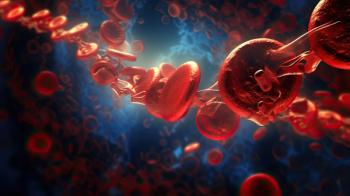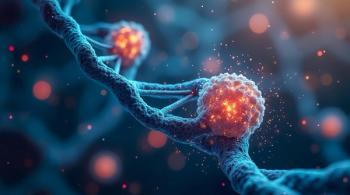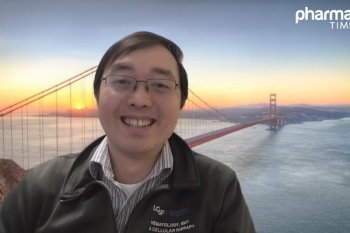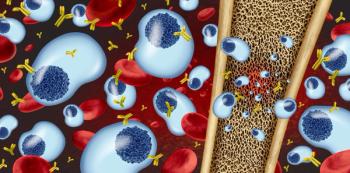
ASCO 2025: Informing Treatment Decisions Using a 14-Gene Assay in Early-Stage NSCLC
Key Takeaways
- A 14-gene classifier identified high-risk early-stage NSCLC patients, reducing recurrence or death by 78% with chemotherapy.
- Disease-free survival (DFS) was the primary end point, showing superiority in the chemotherapy group, prompting early trial termination.
A study reveals a 14-gene assay guides chemotherapy decisions effectively in patients with early-stage non-small cell lung cancer (NSCLC).
Pharmacy Times® interviewed David Spigel, MD, medical oncologist, chief scientific officer at Sarah Cannon Research Institute, who discussed a study on patients with early-stage non–small cell lung cancer (NSCLC) to determine the need for chemotherapy, of which the findings were presented as part of the 2025 American Society of Clinical Oncology Annual Meeting. The study utilized a 14-gene classifier to predict high-risk patients, leading to a 78% reduction in cancer recurrence or death in those receiving chemotherapy. The primary end point was disease-free survival (DFS), which was superior in the chemotherapy group. Currently, the test is commercially available and aids in informed treatment decisions among patients, their families, and health care professionals. Spiegel noted that implementation challenges may arise because of the need for awareness and understanding among health care professionals and patients.
Pharmacy Times: Can you introduce yourself?
David Spigel, MD: I'm David Spigel. I'm a medical oncologist and the chief scientific officer at Sarah Cannon Research Institute in Nashville, Tennessee.
Pharmacy Times: For what reasons was this particular molecular assay chosen for the study? How might it stand out compared with other methods?
Spigel: So, the whole purpose of this study was to inform patients and physicians about who needs chemotherapy when you have early-stage non–small cell lung cancer (NSCLC) after surgery. Stage I, II, and III cancers are cancers that we are trying to eradicate and offer patients a chance for a cure, and we know chemotherapy has an established role in II and III cancers. But in early stage II—say, IIa—and stage I cancers, the role of chemotherapy is still a bit uncertain at times, and so, we use traditional features—such as tumor size, grade, other high-risk features, nodal status, [and so on]—to make decisions about someone's risk of having cancer return. But the goal of this study was to use a gene classifier to help predict which patients would be at the highest risk for recurrence and offer them a chance for chemotherapy where they may not otherwise receive that.
Pharmacy Times: The primary end point of the study was DFS in the modified intent-to-treat population. Can you explain how DFS was defined in this study and why it was chosen as the primary end point, rather than progression-free survival (PFS), overall survival, and so on?
Spigel: For trials with early-stage cancer, often event-free survival (EFS) or DFS would be the end point. Often, progression-free survival (PFS) is an end point we use with advanced disease. So, you're looking to, in this case, see how many patients live without their cancer returning, and so, DFS is a very good end point for early-stage trials, particularly as this is earlier established in colorectal cancer as a surrogate for long-term outcomes. And of course, it's an outcome you can achieve earlier. In fact, this trial was stopped early by the Data Safety Monitoring Board because of the overwhelming efficacy seen in the treatment arm.
And so, as you point out, the 24-month landmark DFS end point was reported early, and just to jump to that, the patients who were scored or classified as intermediate- or high-risk and were [randomly assigned] to chemotherapy had a superior DFS compared with those patients with the same risk who didn't receive chemotherapy. And, as you recall, these patients have stage IA, Ib, or IIa non-squamous NSCLC. The hazard ratio for benefit for chemotherapy in that high-risk group was 0.22, or in other words, there was a 78% reduction in the risk of cancer returning or death in the group that received adjuvant chemotherapy. And hence, why the trial was stopped early.
Pharmacy Times: Was there anything unexpected or particularly interesting about these findings?
Spigel: To back up a little bit, this 14-gene classifier was actually developed prospectively in single cohorts almost 10 years ago, a little over 1500 patients helped validate this assay, and so, it was known that this could have a high-predictive value in sorting out patients with high-risk disease who could benefit from therapy vs those with low-risk disease who do well anyway. But I think it was nice to see this in a prospective, randomized trial, and of course, the results were pretty outstanding, even in a small group of patients. I don't know that it was a "surprise" because the earlier analysis when the assay was being validated suggested that this would be a very strong classifier, and this prospective, randomized effort proved that. So, I don't know that there was a surprise, but certainly was great to see.
Pharmacy Times: What are the immediate next steps in translating these findings into clinical practice? How might the pharmacist play a role in this?
Spigel: The 14-gene classifier is actually available commercially, and so, [health care professionals] can order this test now. It takes about 10 days to get a result back. They need a block or unstained slides to do the analysis. And so, in clinic, you can sit with the patient now who has the stage Ia, Ib, [or] IIa cancer where you're not absolutely certain whether there's a role for chemotherapy, this can help you make those decisions. I think if you know you're doing chemotherapy, there's no role for this test. If you know that you don't want to do chemotherapy as a patient, family, [or] provider, there's no role for this test. But I think if you're uncertain as to whether chemotherapy could play a role in the treatment, this information can help patients, families, and doctors make informed decisions about the risk and benefit of those 4 cycles of adjuvant, platinum chemotherapy.
Pharmacy Times: Do you foresee any challenges when implementing this molecular assay widely, and if so, what steps are needed to overcome them?
Spigel: I think, like any new kind of prognostic test, it could take some understanding. So, this is very similar to what's done in colon cancer and prostate cancer, with tests like Oncotype DX, where doctors use those to help patients make decisions. So, I think it's just a matter of awareness and understanding [that] the process is rather easy, and actually, the product, the test, is covered by most insurance. So, it should be—hopefully—something that gets discussed with patients. Again, it's all about informing patients and doctors to help them make better decisions, whether they want to do chemotherapy or not.
Newsletter
Stay informed on drug updates, treatment guidelines, and pharmacy practice trends—subscribe to Pharmacy Times for weekly clinical insights.




















































































































































































































